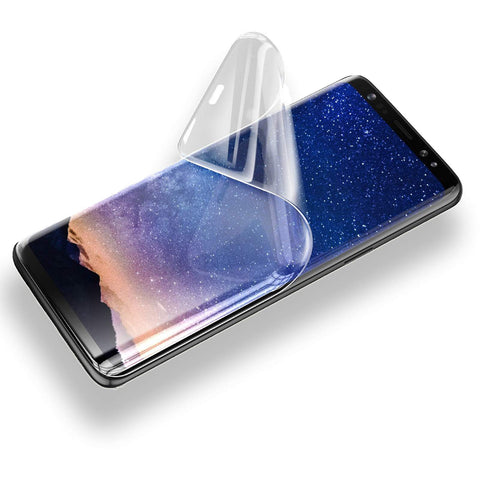Screen protectors play a vital role in safeguarding our devices from scratches, cracks, and other damages. Among the various types available in the market, hydrogel and tempered glass screen protectors stand out as popular choices. However, when it comes to durability, consumers often find themselves deliberating between these two options. This article aims to provide a comprehensive comparison of the durability of hydrogel screen protectors and tempered glass, shedding light on their respective strengths and weaknesses.
What is a Hydrogel Screen Protector?
A hydrogel screen protector is made from a flexible material that utilises advanced hydrogel technology to provide optimal protection for your smartphone's display. Hydrogel technology involves using a gel-like substance that adheres to the surface of your phone's screen without leaving any residue or bubbles behind.
One of the key benefits of using a hydrogel screen protector is its self-healing properties. The material has the ability to repair minor scratches over time by filling in the gaps with its elastic properties. This means that you don't have to worry about small scratches ruining the appearance of your phone's display.
Additionally, hydrogel screen protectors offer excellent clarity and transparency, ensuring that you can enjoy vibrant colors and sharp images on your smartphone without any compromise in visual quality.
What is a Tempered Glass Screen Protector?
On the other hand, tempered glass screen protectors are made from multiple layers of specially treated glass that undergoes intense heating followed by rapid cooling processes to increase its strength and durability.
The primary benefit of using a tempered glass screen protector lies in its superior scratch resistance compared to other materials like plastic or hydrogel. It provides an extra layer of defense against sharp objects such as keys or coins that may accidentally come into contact with your phone's display.
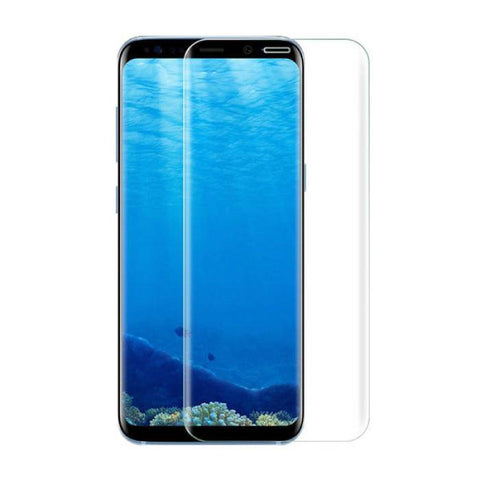
Moreover, tempered glass screen protectors offer excellent impact resistance. In the event of a drop or impact, the protector absorbs and disperses the force, minimising the chances of your phone's screen shattering or cracking.
Durability of Tempered Glass Screen Protectors
Tempered glass screen protectors are renowned for their exceptional durability. Made from chemically strengthened glass, these protectors offer robust protection against scratches, impacts, and even minor drops. The tempered glass undergoes a specialised heating and rapid cooling process, which enhances its strength and resilience.
Scratch Resistance: Tempered glass screen protectors excel in resisting scratches from everyday objects like keys, coins, or abrasive surfaces. Their hard surface effectively prevents minor scratches, maintaining the pristine appearance of your device's screen over time.
Impact Resistance: One of the key advantages of tempered glass is its ability to absorb impacts and distribute the force across the surface, minimising the risk of cracks or shattering. In the event of a drop or collision, the tempered glass protector often bears the brunt, safeguarding the underlying screen.
Longevity: Due to their superior durability, tempered glass screen protectors typically last longer than their hydrogel counterparts. They can withstand extended usage without showing signs of wear and tear, providing reliable protection for your device.
Durability of Hydrogel Screen Protectors
Hydrogel screen protectors have gained popularity for their flexibility and self-healing properties. Composed of a soft, gel-like material, these protectors offer a different set of advantages in terms of durability.
Flexibility: Hydrogel screen protectors are highly flexible and conform easily to the contours of your device's screen. This flexibility allows them to absorb impacts to some extent, reducing the risk of cracks or damage to the underlying screen.
Self-Healing: One of the unique features of hydrogel screen protectors is their ability to self-heal minor scratches and scuffs over time. The soft material has a natural elasticity that enables it to regain its smooth surface, minimising the visibility of imperfections.
Resilience to Certain Impacts: While hydrogel protectors may not offer the same level of impact resistance as tempered glass, they can still provide adequate protection against everyday hazards such as light bumps or scratches.
Comparison on Durability of Hydrogel screen protectors and Tempered Glass
In summary, both tempered glass and hydrogel screen protectors offer distinct advantages in terms of durability. Tempered glass excels in scratch resistance, impact resistance, and overall longevity, making it a preferred choice for users seeking maximum protection for their devices. On the other hand, hydrogel protectors provide flexibility, self-healing capabilities, and resilience to certain impacts, appealing to those who prioritise a softer touch and easy installation.
Ultimately, the choice between hydrogel and tempered glass screen protectors depends on individual preferences, usage patterns, and the level of protection required. By understanding the durability characteristics of each type, consumers can make informed decisions to safeguard their devices effectively.
Impact resistance: which offers better protection for your device?
Impact resistance is a crucial factor when considering screen protectors, as it directly affects the level of protection provided to your device. When comparing hydrogel screen protectors and tempered glass, it's essential to evaluate which offers better protection against impacts.
Tempered Glass Screen Protectors
Tempered glass screen protectors are renowned for their exceptional impact resistance. The manufacturing process involves heating glass to high temperatures and then rapidly cooling it, resulting in a product that is significantly stronger than standard glass. This strengthened glass can effectively absorb and distribute the force of impacts, minimising the risk of damage to the underlying screen. In the event of a drop or collision, a tempered glass protector acts as a barrier, often bearing the brunt of the impact to prevent cracks or fractures on the device's screen. The rigid structure of tempered glass provides reliable protection against various hazards, including accidental drops, knocks, or impacts from sharp objects.
Hydrogel Screen Protectors
Hydrogel screen protectors offer a different approach to impact resistance due to their flexible and soft nature. While they may not provide the same level of hardness as tempered glass, hydrogel protectors possess some degree of impact absorption capabilities. The gel-like material can absorb and dissipate the energy from impacts, reducing the likelihood of damage to the screen underneath. However, it's important to note that hydrogel protectors may not be as effective as tempered glass in preventing severe impacts or heavy falls. Their softness and flexibility make them more suitable for minor bumps and scratches rather than high-velocity impacts.
When it comes to impact resistance, tempered glass screen protectors generally offer better protection for your device compared to hydrogel protectors. The rigid structure and high-strength properties of tempered glass make it highly effective in minimising the risk of screen damage from impacts of varying intensities. However, hydrogel protectors can still provide adequate protection against light bumps and scratches due to their flexible and self-healing properties. Ultimately, the choice between the two types of screen protectors depends on individual preferences, usage habits, and the level of protection required for your device.
Clarity and transparency: how do hydrogel and tempered glass differ?
Clarity and transparency are essential aspects to consider when selecting a screen protector, as they directly impact the visual experience and display quality of your device. When comparing hydrogel and tempered glass screen protectors, it's important to examine how they differ in terms of clarity and transparency.
Tempered Glass Screen Protectors
Tempered glass screen protectors are known for their exceptional clarity and transparency. They are manufactured using high-quality glass materials that undergo specialised processes to ensure optical clarity. As a result, tempered glass protectors provide a crystal-clear view of the device's screen, allowing colors, text, and images to appear vivid and sharp. The smooth surface of tempered glass minimises distortion and glare, enhancing the overall viewing experience. Additionally, tempered glass protectors maintain their clarity over time, resisting smudges, fingerprints, and other blemishes that can obscure visibility.
Hydrogel Screen Protectors
Hydrogel screen protectors offer a different approach to clarity and transparency due to their unique material composition. Made from a soft, gel-like substance, hydrogel protectors may not provide the same level of optical clarity as tempered glass. While they still offer decent transparency, hydrogel protectors may have a slightly matte or textured finish that can affect the clarity of the display. This texture may diffuse light and reduce glare, but it can also diminish the sharpness and vibrancy of colors on the screen. Additionally, hydrogel protectors may be more prone to trapping air bubbles during installation, which can further impact transparency if not properly removed.
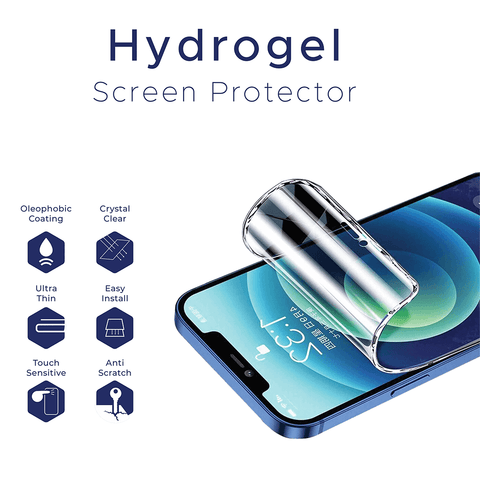
Hence, Tempered glass screen protectors typically offer superior clarity and transparency compared to hydrogel protectors. The high-quality glass construction and smooth surface of tempered glass ensure a clear and unobstructed view of the device's screen, with minimal distortion or interference. On the other hand, while hydrogel protectors still provide decent transparency, their soft and textured nature may result in slightly reduced clarity and sharpness. Ultimately, the choice between the two types of screen protectors depends on individual preferences and priorities regarding visual quality and display clarity.
Ease of installation: comparing the installation process for both types of screen protectors
Ease of installation is a critical factor to consider when choosing a screen protector, as a smooth and hassle-free installation process can save time and frustration. Let's compare the installation process for hydrogel and tempered glass screen protectors:
Tempered Glass Screen Protectors
Installing a tempered glass screen protector typically involves the following steps:
- Clean the device's screen thoroughly with the provided cleaning cloth and alcohol wipe to remove dust, fingerprints, and debris.
- Align the tempered glass protector with the device's screen, ensuring precise placement over the display area.
- Gently lower the protector onto the screen, allowing it to adhere naturally. Most tempered glass protectors come with adhesive backing that sticks to the screen upon contact.
- Use a soft cloth or applicator to smooth out any air bubbles and ensure proper adhesion.
- Finally, double-check the alignment and remove any remaining bubbles for a flawless installation.
Overall, the installation process for tempered glass screen protectors is relatively straightforward and user-friendly, requiring minimal effort and expertise. The rigid structure of tempered glass makes it easier to handle and align accurately during installation, resulting in a smooth and seamless application.
Hydrogel Screen Protectors
Installing a hydrogel screen protector involves similar steps, but there are some differences due to the soft and flexible nature of the material:
- Begin by cleaning the device's screen thoroughly with the provided cleaning supplies to remove dirt, oils, and residues.
- Carefully align the hydrogel protector with the screen, ensuring precise placement and alignment with the device's features such as the camera and sensors.
- Gently apply pressure to the center of the protector, allowing it to adhere to the screen gradually. Avoid applying too much pressure or stretching the hydrogel, as it may distort or tear.
- Use a soft cloth or squeegee to smooth out any air bubbles and ensure proper adhesion across the entire surface.
- Double-check the alignment and adjust if necessary, then allow the protector to set and adhere fully to the screen.
The installation process for hydrogel screen protectors may require slightly more finesse and patience compared to tempered glass protectors. The soft and flexible nature of hydrogel requires careful handling to avoid stretching or distortion during application. Additionally, hydrogel protectors may be more prone to trapping air bubbles, requiring thorough smoothing and adjustment to achieve a bubble-free installation.
In summary, while both types of screen protectors can be installed successfully with proper technique, tempered glass screen protectors generally offer a slightly easier and more straightforward installation process due to their rigid structure and simpler application. However, with careful attention to detail and patience, hydrogel screen protectors can also be installed effectively to provide reliable protection for your device.
Thickness and feel: which type provides a more natural touch experience?
When evaluating screen protectors, thickness and tactile feel are important considerations as they directly impact the user's interaction with the device. Let's compare the thickness and feel of hydrogel and tempered glass screen protectors to determine which type provides a more natural touch experience:
Tempered Glass Screen Protectors
Thickness: Tempered glass screen protectors typically have a thicker profile compared to hydrogel protectors. The thickness of tempered glass protectors can vary depending on the brand and model, but they generally range from 0.3mm to 0.5mm.
Feel: Tempered glass screen protectors offer a smooth and solid feel that closely resembles the device's original glass screen. The rigid structure of tempered glass provides a firm surface for touch interactions, resulting in a tactile experience that many users find satisfying and natural. The smooth texture of tempered glass also facilitates effortless swiping and tapping gestures, enhancing the overall usability of the device.
Hydrogel Screen Protectors
Thickness: Hydrogel screen protectors are typically thinner and more flexible compared to tempered glass protectors. The thickness of hydrogel protectors can vary, but they generally range from 0.1mm to 0.2mm, making them significantly thinner than tempered glass.
Feel: Hydrogel screen protectors offer a softer and more pliable feel compared to tempered glass. The flexible nature of hydrogel allows it to conform closely to the contours of the device's screen, resulting in a smoother and more seamless touch experience. Some users may prefer the slightly softer feel of hydrogel protectors, as it can provide a gentler touch sensation during interactions with the screen.
In summary, when it comes to thickness and feel, the choice between hydrogel and tempered glass screen protectors depends on individual preferences and priorities. Tempered glass screen protectors offer a thicker profile and a solid, tactile feel that closely resembles the device's original screen, making them ideal for users who prioritise durability and a traditional touch experience. On the other hand, hydrogel screen protectors are thinner and more flexible, offering a softer and more pliable feel that some users may find more comfortable for prolonged use. Ultimately, the decision should be based on personal preference and the desired balance between thickness, feel, and overall usability.
Scratch resistance: evaluating the ability of hydrogel and tempered glass to withstand scratches.
Scratch resistance is a crucial factor when selecting a screen protector, as it determines the level of protection against everyday wear and tear that your device's screen will receive. Let's compare the scratch resistance of hydrogel and tempered glass screen protectors:
Tempered Glass Screen Protectors Scratch Resistance
Tempered glass screen protectors are renowned for their exceptional scratch resistance. The hardened glass material undergoes a specialised tempering process, which significantly enhances its durability and resistance to scratches. Tempered glass protectors can effectively withstand scratches from keys, coins, and other sharp objects that may come into contact with the device's screen during daily use. Even with prolonged use, tempered glass protectors maintain their smooth surface and clarity, providing reliable protection against scratches without compromising the user's viewing experience.
Hydrogel Screen Protectors Scratch Resistance
Hydrogel screen protectors also offer decent scratch resistance, but they may not be as durable as tempered glass protectors in this regard. The soft and pliable nature of hydrogel makes it more susceptible to scratches from sharp objects and abrasive materials. While hydrogel protectors can provide some level of protection against minor scratches and scuffs, they may show signs of wear and tear more quickly compared to tempered glass. Additionally, the self-healing properties of hydrogel may help minimise the visibility of superficial scratches over time, but they may not be as effective in preventing deeper scratches or damage to the screen.
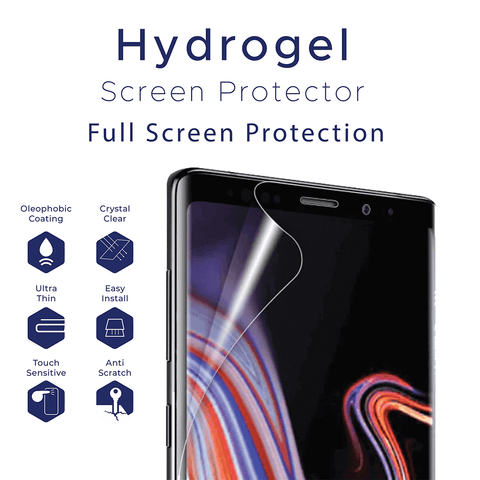
In summary, when evaluating scratch resistance, tempered glass screen protectors generally offer superior durability and protection compared to hydrogel protectors. The hardened glass material of tempered glass protectors provides robust defense against scratches, ensuring long-lasting clarity and protection for your device's screen. While hydrogel protectors can still offer some level of scratch resistance, they may be more prone to damage from sharp objects and may require more frequent replacement to maintain optimal protection. Ultimately, the choice between the two types of screen protectors depends on individual preferences, priorities, and the level of scratch protection desired for your device.
Compatibility Of Hydrogel Screen Protector and Tempered Glass Screen Protector With Different Types Of Phone Cases
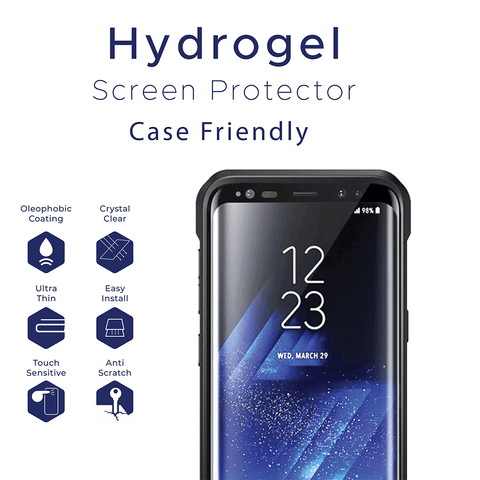
|
Screen Protector Type |
Slim Cases |
Standard Cases |
Heavy-Duty Cases |
|
Tempered Glass |
Compatible: Tempered glass protectors usually work well with slim cases, as they offer minimal interference with the protector's edges. |
Compatible: Many standard phone cases are designed to accommodate tempered glass protectors, providing enough space around the edges for proper adhesion. |
May pose challenges due to thickness and tight fit: Some heavy-duty cases may have a tight-fitting design or thick construction, which can cause compatibility issues with tempered glass protectors. The thickness of the case may prevent the protector from adhering properly or cause lifting along the edges. |
|
Hydrogel |
Highly Compatible: Hydrogel protectors are highly compatible with slim cases due to their thin and flexible nature. They can easily conform to the contours of the screen without adding bulk or interference. |
Compatible: Hydrogel protectors work well with most standard phone cases, offering a seamless fit and reliable protection. The flexible material allows the protector to adhere smoothly to the screen, even when used with cases that provide additional coverage. |
Compatible: Hydrogel protectors are also compatible with heavy-duty or rugged phone cases. Their flexibility allows them to conform to the screen's curvature without compromising protection. The soft and forgiving nature of hydrogel minimises the risk of lifting or peeling, ensuring a secure fit even with thicker cases. |
In summary, while both tempered glass and hydrogel screen protectors can be compatible with various types of phone cases, hydrogel protectors generally offer greater flexibility and adaptability, making them more versatile across different case styles and thicknesses.
Price comparison of hydrogel and tempered glass screen protectors
When it comes to price, both hydrogel and tempered glass screen protectors are available at various price points depending on the brand, model, and additional features offered.
Hydrogel screen protectors tend to be more affordable compared to tempered glass options. They offer excellent value for money considering their durability, self-healing properties, and overall protection provided.
On the other hand, tempered glass screen protectors may have a slightly higher price tag due to their superior scratch resistance and impact absorption capabilities. However, they still offer great value considering the level of protection they provide against accidental drops or impacts.
Fingerprints and smudges: comparing the resistance to fingerprints and ease of cleaning.
|
Screen Protector Type |
Resistance to Fingerprints and Smudges |
Ease of Cleaning |
|
Tempered Glass |
Moderate Resistance: Tempered glass protectors may exhibit moderate resistance to fingerprints and smudges. However, due to their smooth surface, fingerprints and smudges may still be visible, especially after prolonged use. |
Easy to Clean: Tempered glass protectors are generally easy to clean using a microfiber cloth or screen cleaning solution. The smooth surface allows for effortless removal of fingerprints and smudges, leaving the screen looking clean and pristine. |
|
Hydrogel |
High Resistance: Hydrogel protectors often offer high resistance to fingerprints and smudges due to their matte or textured finish. The soft material disperses oils and residues, reducing the visibility of fingerprints and smudges on the screen. |
Moderate Ease of Cleaning: Hydrogel protectors may require slightly more effort to clean compared to tempered glass. While they are still relatively easy to clean with a microfiber cloth or gentle cleaning solution, the textured surface may require additional attention to remove stubborn fingerprints and smudges thoroughly. |
In summary, while both tempered glass and hydrogel screen protectors offer some level of resistance to fingerprints and smudges, hydrogel protectors generally provide higher resistance due to their matte or textured finish. However, tempered glass protectors are easier to clean thanks to their smooth surface, while hydrogel protectors may require a bit more effort to ensure thorough cleaning.
Hydrogel Screen Protectors vs. Tempered Glass Screen Protector: Which is better?
The comparison between hydrogel and tempered glass screen protectors reveals that each type has its own set of advantages and considerations.
Hydrogel screen protectors offer flexibility, self-healing properties, and high resistance to fingerprints and smudges. They are compatible with various phone cases and provide a softer touch experience. However, they may have slightly lower scratch resistance and may require more effort during installation and cleaning.
On the other hand, tempered glass screen protectors excel in durability, scratch resistance, and ease of installation. They offer superior clarity, impact resistance, and are generally easier to clean. However, they may not be as compatible with heavy-duty phone cases due to their rigid structure.
Ultimately, the choice between hydrogel and tempered glass screen protectors depends on individual preferences, priorities, and usage habits. If you prioritise durability and scratch resistance, tempered glass may be the better option. If flexibility, self-healing properties, and resistance to fingerprints are more important to you, hydrogel could be the preferred choice.
Regardless of the type chosen, using a screen protector is essential for protecting your device's screen from scratches, impacts, and other damages, prolonging its lifespan and preserving its appearance.



